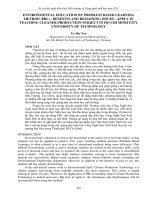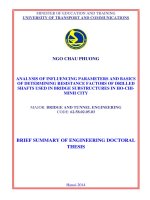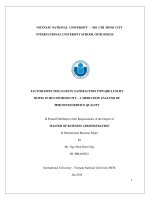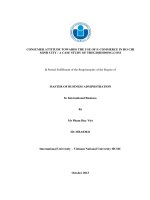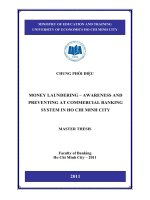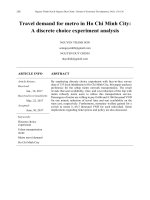Visualizing debt and credit in hồ chí minh city a photographic approach
Bạn đang xem bản rút gọn của tài liệu. Xem và tải ngay bản đầy đủ của tài liệu tại đây (5.06 MB, 21 trang )
PHOTO ESSAY
NICOLAS LAINEZ
“H
ello! There is money. No need for a household certificate, identity
card.” This poster glued to a wall by a moneylender in an alleyway of
Hồ Chí Minh City transformed my research agenda (Figure , all translations
mine). I stumbled upon it by chance while I was conducting field research on
credit and debt in the sex industry. My goal was to understand why Vietnamese sex workers could easily access credit from pimps, employers, and moneylenders despite struggling to repay it, or as one borrower eloquently put it,
why it was “easy to borrow but hard to repay” [khi mượn thì dễ, khi trả mới
khó]. While I was engrossed in decrypting the inner workings of moneylending practices through in-depth interviews and the examination of debt
records, I could not see that the finance sector was thriving in Vietnam, in
particular informal and formal credit markets. The discovery of the poster
made me realize that the walls of Hồ Chí Minh City were covered with ads
from moneylenders. I then realized that banks, pawnshops, and consumer
lending companies were also mushrooming and competing to attract borrowers. In short, by wandering in the streets away from my informants and
looking at credit and debt through the viewfinder instead, I became cognizant
that a financial transformation that took off in the mid-s was occurring.
Although crucial to my study, the change in the financial landscape had
escaped me as it was novel to me. Photography revealed it to me.
Journal of Vietnamese Studies, Vol. , Issue , pps. –. ISSN -X, electronic -.
© by The Regents of the University of California. All rights reserved. Please direct all
requests for permission to photocopy or reproduce article content through the University of
California Press’ Rights and Permissions website, at DOI: />
158
Downloaded from by National University of Singapore user on 27 February 2021
Visualizing Debt and Credit in Hồ Chí Minh
City: A Photographic Approach
VISUALIZING DEBT AND CREDIT IN HỒ CHÍ MINH CITY
A moneylender’s poster in an alley, April–May 2019. Photo by
Nicolas Lainez.
This experience offers a chance to reflect on the role of photography in
research. Photography is a useful tool to generate and represent knowledge, to illustrate reality and gather data about events and communities.
It is also an effective method to understand the context in which individuals and practices are situated. I argue that photography can also be an
inductive research method for moving from the particular to the general,
to see the big picture. Inductive reasoning involves the search for patterns
based on observations and the development of hypotheses and theories to
explain those patterns. I contend that looking at the world through the
viewfinder with an open mind and few preconceptions can help us to
uncover hidden patterns and generate a rich, meaningful, and comprehensive picture of a research problem. This process facilitates the formation of new research perspectives and generalizations based on
observations. I illustrate this argument by describing the reflexive journey
that drove me from photographing debt records in enclosed spaces to
roaming Hồ Chí Minh City’s streets to visually capture a thriving credit
Downloaded from by National University of Singapore user on 27 February 2021
FIGURE 1:
159
160
LAINEZ
boom. The financial transformation that was revealed in my viewfinder
radically changed my research agenda on credit and debt.
This journey started with a job proposition by Alliance Anti-Trafic,
on debt and credit in Hồ Chí Minh City’s sex trade. I took this opportunity
to uncover the mystery behind debt in the lives of stigmatized sex workers,
a topic that provokes anxieties and clichés about exploitation, debt bondage, trafficking, and modern slavery. The social workers from the NGO
arranged interviews with indebted sex workers and their creditors: pimps,
managers of entertainment outlets, and moneylenders. These lenders operate informally and issue loans in the range of VNÐ – million (USD
–) to sex workers without asking for guaranties or paperwork. A few
wealthy lenders give larger loans of several tens of millions of đồng to
selected sex workers operating in high-end karaoke bars for Japanese and
Western clients. In some cases, they make debt contracts that do not specify
interest rates, which can be considered usurious according to criminal law,
depending on the amount loaned and profit generated. Figure provides an
illustrative example. The contract reads “My name is. . . . Date of birth: . . . ,
HCM City. ID: . . . Today, on --, I have borrowed from . . . a loan
of million (fifty million đồng). I will pay million in advance on -. For the remaining million, I will pay capital plus interest each
month until it’s paid off. [date and signature].” The agreement shows that
these informal lenders go through some formalities, such as an acknowledgment of the loan, which exposes the borrower. However, the lenders are
protected because their names and the loans’ conditions and interest are
not recorded. In case of default, the lender can also bring the agreement to
the district people’s committee to reach an out-of-court settlement, even if
the document is not notarized. Hence, debt agreements are not favorable to
borrowers.
Pimps, managers of entertainment outlets, and moneylenders offer two
types of loans to sex workers. The first, tiền góp [money collected, or capital
paid on installments], compels the borrower to repay the principal and
interest through daily installments for an agreed period, usually twentyfour days, with a monthly interest rate of percent. The second, tiền đứng
Downloaded from by National University of Singapore user on 27 February 2021
a Vietnamese NGO I have worked with for more than a decade. To better
understand the lives of sex workers, this NGO asked me to conduct a study
VISUALIZING DEBT AND CREDIT IN HỒ CHÍ MINH CITY
A debt contract between a moneylender and a borrower for a VNÐ
50 million loan (the borrower’s name, date of birth, and phone number are
pixelized to maintain anonymity), April–May 2019. Photo by Nicolas Lainez.
[standing money, or principle remains unpaid], requires borrowers to pay
– percent every day in interest until they repay the principal. Sex workers
take these loans to fund consumption expenditures, especially
Downloaded from by National University of Singapore user on 27 February 2021
FIGURE 2:
161
162
LAINEZ
contingencies, as they are unbanked and distrustful of the banking system.
In addition, many are internal migrants who lack the paperwork required
to open a bank account, in particular a regularized household certificate,
loans and lenders, “borrowing here to repay there,” and extending their tiền
góp and tiền đứng loan terms.
Serial borrowing can lead to entrapment, a process that debt ledgers
illustrate vividly. Figure is a page from an informant’s debt ledger that
shows four extensions of a tiền góp loan. The numbers in the columns are
dates (/ means October ), and the crosses signal a daily installment.
The line at the bottom of the first columns means “ million minus
million = million minus , = . million.” The informant took
a VNÐ million (USD ) tiền góp loan and repaid VNÐ million
(USD ) over sixteen days (the daily installment is VNÐ , or USD
), after which she owed VNÐ million (USD ). She then borrowed
VNÐ million to keep the same principal of VNÐ million and the same
installment and start a new twenty-four-day cycle. However, she only
received VNÐ . million (USD ) as the lender charged a VNÐ
, (USD ) fee for topping up the loan. The key finding is that the
ledger is filled with extensions made over two years. The informant had
recorded daily installments of tiền góp loans to prevent being cheated by
her lenders and to know when she could top up her loan again, usually
around day fifteen in a twenty-four-day cycle. At the same time, she had
taken on tiền đứng loans that she did not record. She cared only about how
much she owed every day, not the interest she had paid over time. Not
calculating the interest paid eased her anxiety. Overall, Figure is worth
a thousand words, as it provides a graphic illustration of serial borrowing. It
also shows the level of detail that is required to grasp the inner workings of
money lending, with its juggling practices. However, one cannot see the
forest for the trees by looking at details. As useful as debt records are, they
cannot show the big picture.
The poster in Figure rendered visible a reality that was hidden in
plain sight but was not obvious to me then: the colonization of Hồ Chí
Downloaded from by National University of Singapore user on 27 February 2021
long-term temporary residency, or permanent residency in Hồ Chí Minh
City. They often struggle to keep up with daily installments and juggle with
VISUALIZING DEBT AND CREDIT IN HỒ CHÍ MINH CITY
A page from a sex worker’s debt ledger showing four extensions of
a tiền góp loan, April–May 2019. Photo by Nicolas Lainez.
Minh City’s urban landscape by informal finance. The poster showcased
moneylenders in a whole new light: besides lending money to sex workers
and workers more generally, collecting daily installments, and using
Downloaded from by National University of Singapore user on 27 February 2021
FIGURE 3:
163
164
LAINEZ
Moneylender posters on alley walls, April–May 2019. Photo by
Nicolas Lainez.
harassment and physical violence to recover defaulting loans, they were
also displaying their products in full view to attract unbanked, credithungry borrowers. The city became an unexpected field of investigation
saturated with visual cues about credit. I quickly realized that moneylenders’ posters were everywhere: walls, houses, benches, poles, storefronts, ATMs, power boxes, and gas stations. These posters convey
a simple but effective message: moneylenders’ finance is convenient, flexible, and speedy. The posters in Figure read: “Borrow funds. No fee.
Photocopy of ID, household certificate. Our apologies if this ad is inconvenient.” In Figure , the poster on the upper left-hand corner reads:
“Borrow capital, pay on installments. Introduce a client and get a bonus.”
The one in the center reads: “Borrow money quickly. Disbursement
within the day (household certificate + ID).” The poster at the bottom
indicates: “Lending on installments. Simple procedures. Need identity
card and household certificate.” Last, the black poster on the upper
right-hand side says: “Money for lending.” These messages meet
Downloaded from by National University of Singapore user on 27 February 2021
FIGURE 4:
VISUALIZING DEBT AND CREDIT IN HỒ CHÍ MINH CITY
Moneylender posters on alley walls, April–May 2019. Photo by
Nicolas Lainez.
borrowers’ expectations for efficient and prompt loans. While focusing on
posters and walls, I also started to discover the world surrounding them.
Exploring the maze of Hồ Chí Minh City’s alleyways revealed the presence of many other lenders. In Figure , the poster glued at the bottom of
a power box reads: “Borrow funds. No fee. Photocopy of ID, household
certificate.” At the top, another poster promotes a project of low-cost
houses and apartments developed by Vingroup, the largest private conglomerate specialized in real estate, retail, and services ranging from health
care to finance. It reads “VinCity in District . Townhouse and apartment
buildings. You only need VNÐ million [USD ,] and monthly
installments of . million [USD ] to have a home in VinCity.”
Vingroup partnered with Techcombank to propose mortgage loans to
homebuyers. Credit became key to securing a home and a middle-class
lifestyle, which are sought after by most Vietnamese. Most crucially, Figure juxtaposes two different types of financing. While moneylenders offer
Downloaded from by National University of Singapore user on 27 February 2021
FIGURE 5:
165
166
LAINEZ
The juxtaposition of posters from Vingroup and a moneylender,
April–May 2019. Photo by Nicolas Lainez.
quick loans for consumption, a financial group supplies credit to make the
dream of homeownership seem real.
The mixture of informal and formal finance piqued my curiosity. Figure shows moneylenders’ posters that read: “Financial support. No need
Downloaded from by National University of Singapore user on 27 February 2021
FIGURE 6:
VISUALIZING DEBT AND CREDIT IN HỒ CHÍ MINH CITY
Moneylender posters next to FE Credit headquarters, April–May
2019. Photo by Nicolas Lainez.
for a household certificate, ID” and “Lending money. Pay on installments.
No mortgage. Simple procedure. Disbursement within the day. No fee.
Introduce a client and get a bonus.” These notices are placed next to FE
Credit headquarters, the consumer finance branch of VPBank and a major
player in “unsecured consumer lending” (the tagline under the FE Credit
logo).
Figure illustrates the contrast of informal and formal finance as well.
The left-hand side of the image shows electric poles with posters that
read: “Lending money, pay daily installments.” In the lower right-hand
corner, a signboard advertises an installment plan for a smartphone:
“Vivo V. Price only ,,Ð [USD ]. Pay on installments, zero
interest.” In the upper right-hand corner, there is a billboard from Agribank (an acronym for Vietnam Bank for Agriculture and Rural Development), the largest commercial bank by total capital, total assets,
number of employees, size of operating network, and number of clients.
Founded in , Agribank played a vital role in financing rural
Downloaded from by National University of Singapore user on 27 February 2021
FIGURE 7:
167
168
LAINEZ
The contrasting marketing for informal loans (on the electric poles),
an installment plan for purchasing a smartphone, and financial services by
Agribank, April–May 2019. Photo by Nicolas Lainez.
households and agricultural production in the early years of the Đổi Mới
macroeconomic reforms that aimed to put Vietnam on the path toward
a socialist-oriented market economy. The billboard advertises financial
services such as savings, domestic and international money transfer,
currency exchange, personal and corporate credit, insurance, and commercial finance. On the left side, it features the logos of EVN Finance,
Prudential Finance, Agribank Internet and e-mobile banking, and Western Union. A row of ATMs is located under the billboard. All in all,
Figures – show that moneylenders and bankers are engaged in asymmetric warfare: while the former place cheap posters on utility poles and
boxes (which could be considered vandalism), the latter hang large and
nicely printed billboards on the walls and entrances of large offices and
stores. These pictures also reveal a key term upon which lenders build
their marketing: trả góp [pay in installments].
Downloaded from by National University of Singapore user on 27 February 2021
FIGURE 8:
VISUALIZING DEBT AND CREDIT IN HỒ CHÍ MINH CITY
A motorbike dealer advertises installment plans, April–May 2019.
Photo by Nicolas Lainez.
Once I zoomed out and set my radar to detect trả góp, the term
popped up everywhere. Unlike a decade ago, most consumer goods and
services can now be purchased on installment plans: mobile phones, TV
sets, karaoke players, photo and video cameras, computers, game
Downloaded from by National University of Singapore user on 27 February 2021
FIGURE 9:
169
170
LAINEZ
An electronics and home appliance shop advertises installment
plans.
consoles, washing machines, refrigerators, home renovation plans, travel
packages, health services, and so forth. Figure depicts a motorbike
dealership that carries Asian and Western brands such as Honda, Yamaha, Suzuki, Ducati, KTM, Piaggio, Lifan, Sym, and Kymco. The billboard on the left side reads: “Pay for your vehicle in installments.”
Figure shows the front of an electronics and house appliances store.
The billboard reads, “Pay on installments. Zero percent interest rate.” In
brief, installment plans are showcased on gigantic billboards situated
along busy roads to garner as much attention as possible. They shine
brightly and attract the attention of drivers and pedestrians from hundreds of meters away.
Not only is credit widely advertised, but it is also easily accessible. FE
Credit, Home Credit, and HD Saison, the leading consumer finance
firms in Vietnam, offer installment loans with simple procedures. Customers just need to submit a copy of their ID card, household certificate,
and a recent bill to purchase a mobile phone or a motorbike by
Downloaded from by National University of Singapore user on 27 February 2021
FIGURE 10:
VISUALIZING DEBT AND CREDIT IN HỒ CHÍ MINH CITY
A pawnshop advertises its (non)financial services on a busy road,
April–May 2019. Photo by Nicolas Lainez.
installment with a monthly interest rate of .–. percent. These simple
procedures challenge the assumption that formal banking is unable to
compete with moneylenders’ efficiency. Most crucially, the images in
Figure and Figure took me out of the maze of alleyways and onto
Downloaded from by National University of Singapore user on 27 February 2021
FIGURE 11:
171
172
LAINEZ
A pawnshop, April–May 2019. Photo by Nicolas Lainez.
the main roads, where the large billboards allowed me to be more aware
of the consumer lending industry. They also incited my curiosity about
the physical location where credit is provided and paid back.
To understand lenders better, I zoomed in again. Pawnshops were my
first target. When I started to search for them in my neighborhood, I
noticed a pawnbroker every two hundred meters. Many operate in small
stores that sell mobile phones. These neighborhood pawnshops cater to
local clients and advertise their services. However, other pawnshops
attract a broader spectrum of customers by advertising their services on
billboards and using signs that light up and play music. Figure shows
a pawnshop that sells phones and phone accessories. The upper screen
says: “Pawning. Prestige, low interest rate.” The billboard beneath reads:
“Buy and repair. Replacement phone. Simcard, top-up cards, phone parts
on sale. Pawning—prestige, low interest percent. Car, moto, mobile
phone, laptop.” Other pawnshops have larger offices that display laptops
and phones on sale, such as in Figure . Pawnshops are controversial in
Vietnam, as they are viewed as “hives of criminal activity.” As explained
Downloaded from by National University of Singapore user on 27 February 2021
FIGURE 12:
VISUALIZING DEBT AND CREDIT IN HỒ CHÍ MINH CITY
A small Đồng Shop Sun store, a legal consumer loan company,
April–May 2019. Photo by Nicolas Lainez.
by one of my informants, the head of a “black credit” [tín dụng đen] gang,
a popular term that refers to moneylending gangs and practices, some
moneylenders use pawnshops as fronts to receive products as collateral
without asking for any certificate of origin or ownership, and they charge
interest of up to percent per month, two practices that go against the
law. In any case, the visual marketing of pawnshops distinguishes them
from other consumer lenders.
My second target was consumer loan companies. Figure was taken
at the back of a gas station. Đồng Shop Sun is a registered lending firm
whose primary business is providing unsecured loans and mortgages. The
banner reads: “Consumer credit support. Reputable service – security –
disbursement within hours.” This type of lending shop is mushrooming in Hồ Chí Minh City. While outsiders struggle to detect them, customers also struggle to establish their legality. Some companies belong to
global or Vietnamese financial groups, but others are run by
Downloaded from by National University of Singapore user on 27 February 2021
FIGURE 13:
173
174
LAINEZ
moneylenders and black credit gangs. To make matters more confusing,
some moneylenders operate legal trades—they sell genuine luxury products and rent real vehicles—as fronts for selling tiền góp and tiền đứng
asserting the legitimacy of some consumer lending shops and differentiating between legal and illegal activities call into question the divide
between formal and informal finance. As research has extensively shown,
the line between the two is blurred and largely irrelevant in countries
undergoing financial transformation, where informality remains entrenched. On the whole, Figures – took me back to observing lenders’ presence and advertising in the urban landscape.
In conclusion, when I started interviewing my informants and photographing debt records in Hồ Chí Minh City, my initial objective was to
shed light on the inner workings of money lending, debt juggling practices, and the risk of entrapment. I used photography as a basic and
mechanical tool to reproduce documents and generate illustrative data.
My field investigation was both inductive and deductive: I began exploring my research problem with an open and curious mind, but I also
collected data to test hypotheses and concepts derived from debt theory
and economic anthropology. The discovery of the moneylender poster in
an alleyway was a “revelatory moment of fieldwork” that triggered an
intense emotion and a change of course. The poster shed light on a radical socioeconomic transformation that started recently and was hidden in
plain sight. Photography became an inductive tool to visually capture
financial transformation, a process that I could not yet grasp because I
was theoretically unequipped.
At first, my visual exploration was driven by credit advertising. I wandered the streets and let curiosity and instinct guide me with no goal in
mind. Karen O’Reilly argues that ethnographers work both inductively—
not wanting to restrict themselves to rigid theories and hypotheses—and
deductively, acknowledging the impossibility of total openness and therefore the need to start with loose frameworks. My visual journey from debt
ledgers to credit marketing was inductive, or perhaps simply exploratory, as
I could not—and did not want to—move back and forth between data and
Downloaded from by National University of Singapore user on 27 February 2021
loans. A sex worker from my study showed me a purchase agreement for
perfume that was actually a disguised debt contract. The difficulties in
VISUALIZING DEBT AND CREDIT IN HỒ CHÍ MINH CITY
GrabPay and Moca advertise a cashless payment solution, April–
May 2019. Photo by Nicolas Lainez.
interpretation, theory and analysis, due to my lack of preparation. I set out
to walk and drive along the busy streets of Hồ Chí Minh City according to
desire and pleasure, piecing together discoveries, hints, and intuition as if
on a treasure hunt.
Downloaded from by National University of Singapore user on 27 February 2021
FIGURE 14:
175
176
LAINEZ
What treasure did I find through the viewfinder? The rough gems were
the hundreds of pictures that I accumulated day after day, with credit and
street marketing being their sole connecting characteristics. To unearth
diamonds when I connected them to academic debates about credit, debt,
and financialization in emerging economies. Once I made this step, the
images revealed crucial areas of study that have set my research agenda
for years to come, in particular the mingling and blurring of formal and
informal finance, a credit fever that fuels swelling household debt, and the
explosion of digital finance aimed at boosting financial inclusion and
a cashless society.
Digital finance poses a challenge to photographers: it exists and expands in the virtual world and on mobile phones through apps, but its
material infrastructure remains invisible and thus difficult to grasp and
photograph. Like dark matter or the air, it is everywhere but remains
invisible. Figure shows a billboard from Grab, a Singapore-based technology firm spreading across Southeast Asia that offers ride-hailing transport services, food delivery, payment solutions (in this case with Moca
Payment Systems), and financial services including insurance to millions
of consumers and loans to Grab drivers. The billboard reads: “For convenience, for profit. The most awaited e-wallet that pays for all your needs
with countless attractive offers every day. Quickly activate your e-wallet.”
This picture could be the start of an exploration into the ongoing digital
transformation and the fourth industrial revolution. How should I proceed given that digital finance is invisible? This is the exact question I
asked myself when I stumbled upon the poster from the moneylender in
the alleyway. Perhaps these hints may show others how to use photography to decipher this riddle.
NICOLAS LAINEZ is a Visiting Research Fellow at the Institute of Southeast
Asian Studies in Singapore and Adjunct Assistant Professor at the
Department of Southeast Asian Studies, National University of Singapore.
He has worked as a photojournalist documenting sex trafficking, irregular
migration, sex work, HIV/AIDS, and child labor in Asia for the
Downloaded from by National University of Singapore user on 27 February 2021
these jewels, I had to continually adjust my viewing angle by zooming in
and out, moving about, changing my lens. These jewels became fine
VISUALIZING DEBT AND CREDIT IN HỒ CHÍ MINH CITY
177
international media and the development sector. His current research
project examines financial transformation underway in Vietnam from the
lens of default risk.
While conducting research on debt in the lives of sex workers in Hồ
Chí Minh City, I stumbled upon an ad a moneylender had glued to
a wall. It revealed that financialization was thriving in Vietnam, and
more specifically that credit was rapidly expanding and colonizing the
urban landscape. Photography became a tool to visually capture this
radical financial transformation. This article argues that photography
can be an effective inductive research method for moving from the
particular to the general and seeing the big picture. I contend that
looking at the world through the camera viewfinder with an open
mind can help us to uncover hidden patterns and generate a rich
and meaningful overall picture of a research problem. This process
facilitates the formation of research perspectives and generalizations
based on observations. I support this argument by describing the
reflexive journey that drove me from photographing debt records in
enclosed spaces to wandering in Hồ Chí Minh City’s streets to document
a thriving credit boom. This journey radically transformed my research
agenda on credit and debt.
KEYWORDS:
Photography, inductive research, credit, debt, Vietnam
Notes
. Lainez, Nicolas, Quỳnh Nguyễn Vũ Thúy, Lê Bùi Thảo Uyên, and Georges
Blanchard, “Easy to Borrow, Hard to Repay”: Credit and Debt in Ho Chi Minh
City’s Sex Industry, Research Report no. (Hồ Chí Minh City: Alliance AntiTrafic, ).
. Sten Langmann and David Pick, Photography as a Social Research Method (New
York: Springer, ).
. John Collier and Malcolm Collier, Visual Anthropology: Photography as
a Research Method (Albuquerque: University of New Mexico Press, ).
. Karen O’Reilly, Key Concepts in Ethnography (Los Angeles: Sage, ).
Downloaded from by National University of Singapore user on 27 February 2021
ABSTRACT
178
LAINEZ
Downloaded from by National University of Singapore user on 27 February 2021
. “Pawnshops Hives of Criminal Activity in Ho Chi Minh City: Exposé,” Tuoi Tre
News, May , , (accessed November , ).
. Nina Bandelj, “On Postsocialist Capitalism,” Theory and Society , no. ():
–; James Deborah, Money from Nothing: Indebtedness and Aspiration in
South Africa (Stanford, CA: Stanford University Press, ).
. David Trigger, Martin Forsey, and Carla Meurk, “Revelatory Moments in
Fieldwork,” Qualitative Research , no. (): –.
. O’Reilly, Key Concepts.
